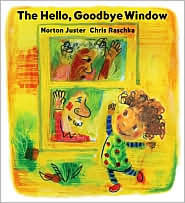Bibliography
Justor, N.(2005). The Hello, Goodbye Window. New York: Hyperion Books for Children.
Book Summary
Book Summary
A little girl shares the joyous time she spends at her grandparents’ house. The kitchen window which “looks like a regular window but, it’s not” is the focal point of their activities. Poppy and Nanny use the kitchen window to look out for visitors, make silly faces, wave hello, look at their reflections, watch the stars, wave goodbye, and generally enjoy the world outside. The little girls explores her grandmothers garden, rides her bike, listens as Poppy plays his harmonica to just the one song “Oh, Susannah”. In the evening, when her parents come to pick her up, she is a little sad to leave her grandparents house but also happy to be going home.
My Impression
This book is fun and full of imagination. There is no dull moment in the little girl’s day. The author uses simple language to tell the story. Normal activities such as passing by the kitchen window, having supper “when it’s dark outside”, or just sitting in the kitchen turn into an adventure. The kitchen window is the center of numerous magical moments between the girl and her grandparents. The window fuels the little girl’s imagination. It functions as a mirror, a place to be playful, “you can climb up on the flower barrel and tap the window, then duck down and they won’t know who did it”, or a place to make silly faces. The illustrations mimic a child’s drawings. The colors are bright and refreshing. They create a playful mood and as one follows the little girl from one adventure to the next, it's impossible not to make silly faces at the kitchen window, listen to poppy ingeniously play "Oh, Susannah", and be "happy and sad " as the parents pick up the little girl in the evening.
Reviews
Booklist
PreS-Gr. 2. Two well-known names come together in a book that speaks to the real lives of children and their experiences. The young narrator visits her grandparents, Nanna and Poppy, in their big house. They explore Nanna's garden, and Poppy plays his harmonica. The narrator rides her bike and takes a nap, and nothing happens till I get up. Looking out the picture window, the hello, goodbye window, she sees the pizza guy, and, more fancifully, a dinosaur. She also spots her parents coming to pick her up. The curly-haired girl is happy to see them, but sad because it means the end of the visit. The window imagery is less important than the title would make it seem. More intrinsic is Juster's honest portrayal of a child's perceptions (a striped cat in the yard is a tiger) and emotions (being happy and sad at the same time just happens that way sometimes). Raschka's swirling lines, swaths, and dabs of fruity colors seem especially vibrant, particularly in the double-page spreads, which have ample room to capture both the tender moments between members of the interracial family and the exuberance of spending time in the pulsating outdoors, all flowers, grass, and sky. --Ilene Cooper Copyright 2005 Booklist
(March 15, 2005; 0-7868-0914-0)
PreS-Gr. 2. Two well-known names come together in a book that speaks to the real lives of children and their experiences. The young narrator visits her grandparents, Nanna and Poppy, in their big house. They explore Nanna's garden, and Poppy plays his harmonica. The narrator rides her bike and takes a nap, and nothing happens till I get up. Looking out the picture window, the hello, goodbye window, she sees the pizza guy, and, more fancifully, a dinosaur. She also spots her parents coming to pick her up. The curly-haired girl is happy to see them, but sad because it means the end of the visit. The window imagery is less important than the title would make it seem. More intrinsic is Juster's honest portrayal of a child's perceptions (a striped cat in the yard is a tiger) and emotions (being happy and sad at the same time just happens that way sometimes). Raschka's swirling lines, swaths, and dabs of fruity colors seem especially vibrant, particularly in the double-page spreads, which have ample room to capture both the tender moments between members of the interracial family and the exuberance of spending time in the pulsating outdoors, all flowers, grass, and sky. --Ilene Cooper Copyright 2005 Booklist
Use in a Library Setting
This book can be used in a classroom to get children to share about their relationship with favorite family members. The teacher can ask students to write a story about the best time they ever had with a favorite family member or members. The teacher should encourage them to use their imaginations in the story as well as the drawings.
References/citations:
Book image from Barnes and Noble at:
http://search.barnesandnoble.com/The-Hello-Goodbye-Window/Norton-Juster/e/9780786809141/?itm=1&USRI=the+hello+goodbye+window
